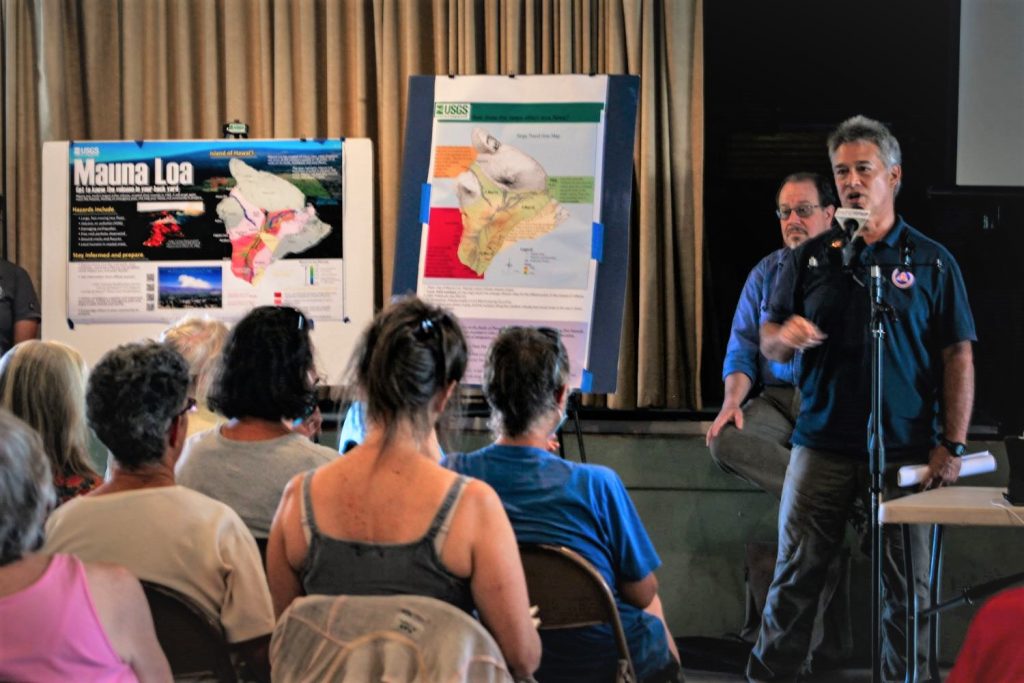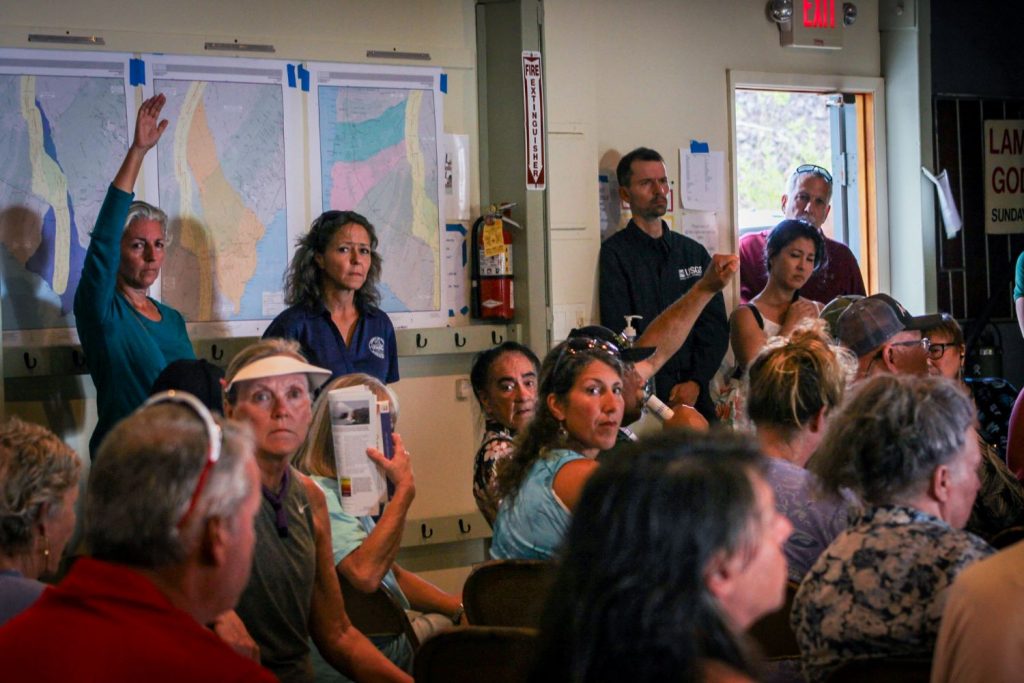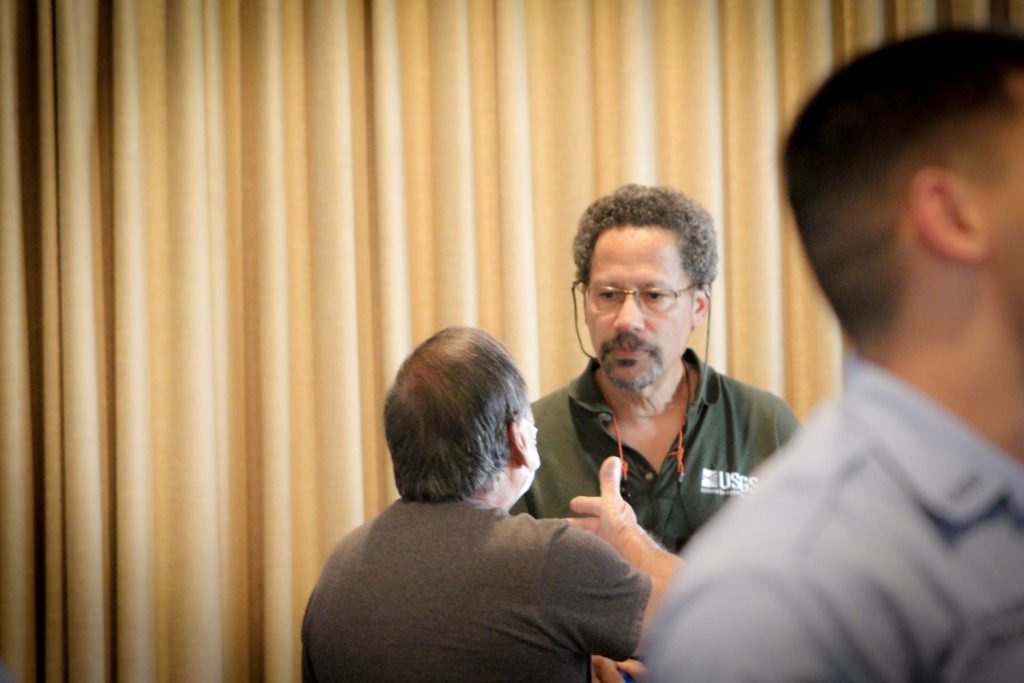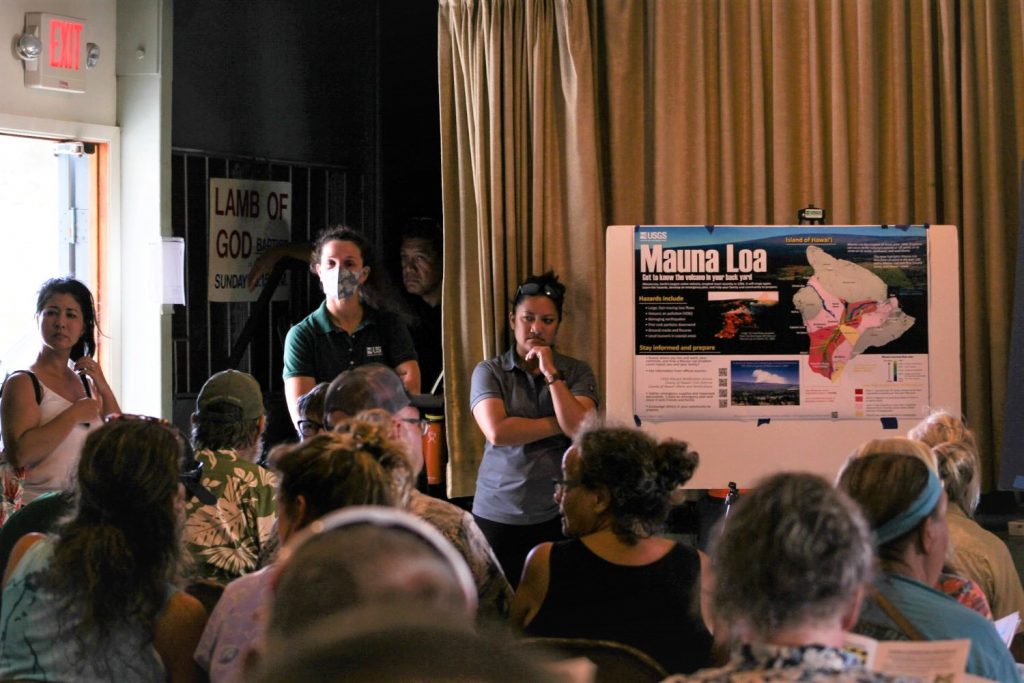The message Ocean View residents were told about Mauna Loa: Be prepared
Anxious. Nervous. Confused. Definitely concerned. Perhaps even a little frightened.
Emotions ran high Saturday afternoon at the Ocean View Community Center overflowing with residents living in the community nearly 2,000 feet above sea level on the steep southwest flank of Mauna Loa.

They got an update about the sleeping giant’s status and had a chance to speak with and ask questions of officials from Hawai‘i County Civil Defense, the Hawaiian Volcano Observatory and other agencies.
The volcano has been at the yellow, or advisory, alert level since 2019. Recent heightened unrest, including a spike in earthquake activity and inflation at the summit, is being driven by renewed input of magma 2 to 5 miles below Mauna Loa’s summit. It’s been a cause for concern for residents who live on the volcano’s slopes.
The last time Mauna Loa erupted was in 1984 and scientists say it will erupt again.
Hawai‘i County Civil Defense administrator Talmadge Magno, Hawaiian Volcano Observatory Scientist-in-Charge Ken Hon and their partners did their best to answer the community’s questions about the 13,681-foot-tall shield volcano — which takes up 51% of the Big Island’s surface area.
In the end, however, it all boiled down to being prepared.

Although scientists now have more instrumentation to tell them what the volcano is doing than during any prior period of unrest or eruption, there’s still no way to accurately forecast when the volcano will erupt.
That means scientists won’t be able to say if lava is coming down one of Mauna Loa’s rift zones until it’s already advancing.
Fortunately, eruptions historically begin and stay confined to the volcano’s summit caldera.
Frank Trusdell, a geologist with the Hawaiian Volcano Observatory who has spent most of his career studying and monitoring Mauna Loa, said about half of Mauna Loa’s 33 past eruptions have remained confined to the caldera region.
About a quarter have happened in the volcano’s Northeast Rift Zone, which includes communities such as Hilo, Volcano and Keaʻau, while the majority of the rest happened in the Southwest Rift Zone. That’s where Ocean View and other communities such as Pāhala are located.
Whether an eruption moves to other locations on the volcano is a different story. But when lava does break out of fissures or radial vents, those flows can move rapidly. Trusdell said when Mauna Loa erupted in 1950 in the Southwest Rift Zone, lava made it to the ocean within three hours.
Hon said the volcano’s alert level won’t be changed until the Hawaiian Volcano Observatory knows with certainty an eruption is going to happen. That’s when people need to take action, but the amount of time to do so in that situation can be very short. That’s why it’s important to be prepared.
Trusdell said while an eruption is not imminent, residents need to stay informed and be aware of the possible hazards associated with living on an active volcano. Magno said that’s why Civil Defense and the other agencies are hosting a series of informational meetings around the island.
“We have to be prepared,” Magno said. “You guys have to be prepared.”
The volcano is going to erupt again at some point, but emergency officials can’t wait until then to address the community, especially in the Southwest Rift Zone, where residents could have only hours to evacuate if lava threatens.
There is a host of agencies that will respond to an eruption. All of them will be on the ground to help residents when an eruption happens. That includes keeping people informed and updated via all available avenues of communication, opening emergency shelters, helping evacuation efforts, opening additional evacuation routes and more.
Civil Defense and its partner agencies are committed to keeping the community safe. But they can’t do it on their own. Magno encouraged residents to have plans in place if they have to evacuate. They need to make sure they are ready to leave and have what they need to survive — that’s the priority.
Messaging during an eruption will be specific and include as much information as possible to make sure people know what they need to do. Hon said it will happen in real time and fast.
“You might not want to wait until you can look out your backdoor and see the glow,” he said.
All emergencies start locally, a representative of the Hawai‘i Emergency Management Agency said Saturday. Magno added that there are so many variables with each eruption. That’s why it’s critical to be prepared.
“You know your community. You know where you sit in the rift zone. You have to come up with a plan,” he said.
Magno, Hon and the other officials in attendance at Saturday’s meeting did their best to answer the community’s questions, which ran the gamut of where people should go if they have to evacuate to what is the best insurance to get to protect their property. But for some, their answers missed the mark.
Leebert Naboa, who has lived in Ocean View for about 30 years, said he was put in charge of devising a plan for his church to make sure kupuna can be evacuated if Mauna Loa erupts in the middle of the night. He came up with a plan to get people to Pohue Bay, which is deep enough for a U.S. Coast Guard cutter. He shared that plan with officials during Saturday’s meeting.
“The concern is if the west rift does erupt and there’s a finger of lava goes to Kahuku Ranch and another finger goes to Miloliʻi, and then we’ll be trapped over here,” Naboa said after the meeting.
He said he didn’t get all of his questions answered, but he wanted to put his idea out there so people could hear it as an option instead of staying put and waiting if an eruption does happen.
Annie Bosted has lived in Ocean View for nearly 14 years. She’s concerned about a possible Mauna Loa eruption, but she’s not afraid.
“Obviously, if one happens, my life’s gonna be turned upside down, but there’s nothing I can do about it,” Bosted said after Saturday’s meeting. “I hope it doesn’t happen, but the mountain’s gonna do what it wants to do. I’m not gonna stop it.”

She doesn’t think the government is doing everything it can to protect the community. Bosted even suggested to officials that more roads are needed makai of Ocean View so residents have more routes to evacuate. They don’t have to be fancy, she said; they could simply be emergency routes that are only open when needed, similar to how Chain of Craters Road was opened up during the 2018 Kīlauea eruption in Puna to provide another way out of the area.
She also suggested after the meeting that barriers could be built in areas prone to eruption to at least slow lava flows down if they happen. Bosted knows those barriers wouldn’t stop the flows completely, but thinks they could give residents a little more time to get out if needed.
“If it’s not needed, oh well, and if it’s needed, it’s gonna save an awful lot of lives,” she said.
She thinks the bottom line is that Ocean View is on its own if lava starts to flow in its direction.
“I think for them to try and convince us that they’ve got it all under control is not gonna work,” Bosted said. “I think people need to take responsibility for themselves and prepare for it and not count on the government or the state or anyone to help, because I don’t think they can get help to us.”
The next meeting in the informational series is scheduled for 5 p.m. Oct. 27 at the Kaʻū District Gym in Pāhala.
For more information about the monitoring of Mauna Loa, click here. To get alerts from Hawai‘i County, click here.



Sponsored Content
Comments








